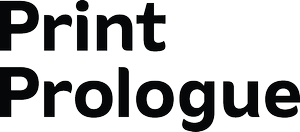PAPER
Paper is one of the most important tools used to establish the tone and quality of a piece. During the initial phases of the design process, we spend the most time sifting through paper and color swatches. The goal is to elicit a response from the audience, no matter how subtle. When the user sees a piece for the first time they will either have a connection to the piece or complete disassociation with it.
Paper Texture
The tactility of the paper you choose is up top on the list when thinking about how your piece will communicate the feeling you are trying to convey. Many uncoated papers offer a variety of textures—felt, laid, linen, eggshell, smooth, super smooth, stipple. Similarly, coated papers will be offered in a few finishes—gloss, silk/dull, matte. Be purposeful about the paper texture you choose. It may not be appropriate for a piece to have a heavily textured, toothy feel. On the other hand, a slick, glossy look may be too cold and uninviting.
Uncoated or Coated?
Determining this first eliminates nearly half of your options. For me, this simply comes down to—(1) practicality and (2) tone. Does the piece need to be protected from scuffs, fingerprints and a lot of handling? If yes, then a coated paper is required. Do I or my client want a high gloss or softly shining surface? If not, then uncoated for the win.
For Example, Direct Mail
Most are shiny, coated, and smooth (all for a very good, practical reasons). But how often do you pick one up and say to yourself, “I connect with this?” For those items, it’s all about messaging and quick communication. For other pieces, that will be held longer, flipped through or opened, the entire experience while it’s in the hands of the user is important. It should be exciting and easy to look at and feel good in their hands.
Specialty Papers
There are translucent, metallic, synthetic papers, vinyl for more specific design needs. These can add a deeper sense of depth tactility to a piece. The decisions to use papers like these may come down to functionality, value, budget, legibility and the relativity they have to your content.
Brightness & Opacity
When selecting a white paper compare brightness and opacities. Typically, you'll want a sheet that is very opaque so that elements do not show through from the back of the sheet or subsequent page. A brighter white is favorable because it allows for more vivid colors and creates a backdrop for better legibility and contrast of your elements. Keep in mind the higher the opacity and brightness, the more expensive the sheet. So if you can compromise a bit design-wise, these elements can be mediated for cost savings.
Paper Color
Using a colored paper is a great way to add color to a piece without incurring extra printing costs for additional inks. For example, if you are doing a budget-friendly piece and need to keep to one or two spot colors, printing on a colored sheet can add a third color to the palette.
One important factor to consider is the effect the paper color has on the saturation of the ink and overall contrast between your typographic and graphic elements. The difference in appearance of ink on a white sheet versus a cream sheet can be pretty significant. It is up to you to determine whether that is important for your project.
Paper Weight
You‘ll need to choose the appropriate paper weight(s) for your piece. Cover weights are typically used for book covers, folded brochures, postcards, note cards and business cards. Text weights are used for letterhead, book interiors, posters and flyers.
In general, hefty weights evoke a higher level of quality (rightly so because they are more expensive) than thinner stock. It's no always appropriate to use the heaviest option available. If your piece is folding, it should be thin enough to score and fold without ink cracking occurring.
For books and brochures, it's helpful to ask your representative at your printer or local paper distribution center for a full-size paper mock-up based on your specifications. This is a great way to test thickness, overall weight for pieces that that mail and ease folding, opening and closing.
Shells & Overprinting
Sometimes it’s cost effective to print a large volume of “shells” if you anticipate there will be a reoccurring need for future printing on the same template. For example, if your client has 50 employees that need business cards, but plans on doubling the size of their business over the course of the next few years. Printing multi-color business card shells now, and overprinting a single color later for new names and contact information, may be a good idea.


